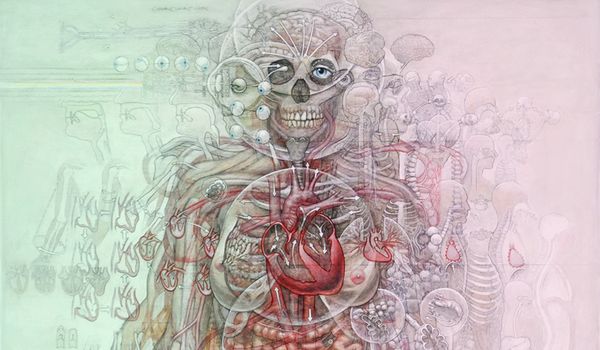Erich Eisenhart • • 5 min read
Heart Consciousness, Love and Enlightened Living
Consciousness & Meditation Psychology & Happiness consciousness

The way is not in the sky. The way is in the heart.
Buddha
The bridge between science and spirituality begins with the heart. The heart is the regulator of our energetic state, working synergistically with the nervous system and the brain to bring coherence and positive emotion to life. It produces the strongest electromagnetic field in the body, one that extends all around us, allowing for energetic communication of this coherence with all of life. Thus, the heart breaks down internal and external environments and allows us access to the oneness of life.
The first part of this article introduces the science of it all, revealing that the heart is the center of our being in terms of our energetic and emotional state and how this organ allows for communication and interaction with all of life.
The second provides exercises to increase coherence and love on a personal and global level. We will dive into learning many loving-kindness meditations.
Neurocardiology
Neurocardiology is the study of the heart in the context of an intelligent system which communicates with the rest of the body and regulates energy. When the heart is in a more coherent state we experience psychological and physiological well-being, an increase in functional performance and overall efficiency
Energy is the most precious commodity to an organism. As human beings we are in a constant flux in our energetic state which is determined by our internal and external environment. Communication from our heart to the rest of our body determines our energetic state.
The regulation of energy starts with the Autonomic Nervous System (ANS), the neural network responsible for oscillating the sympathetic (fight or flight) and parasympathetic (relaxation and digestion) systems of the body. Based upon one’s current environment, these systems work synergistically to effect different functions in the body which have the capability to alter our energetic state. The ever-changing ANS causes heartbeats to vary constantly with a fluctuating environment.
“The normal variability in heart rate is due to the synergistic action of the two branches of the ANS which act in balance through neural, mechanical, humoral and other physiological mechanisms to maintain cardiovascular parameters in their optimal ranges and to permit appropriate reactions to changing external or internal conditions.”1
Therefore, the heart is the hub of both sides of the Autonomic Nervous System. Measuring the variability in heart rate may determine the energetic state of an individual.
Emotions have a direct impact on Heart Rate Variability (HRV), thus one’s overall energetic state. “During the experience of negative emotions…heart rhythms become more erratic or disordered, indicating less synchronization… between the parasympathetic and sympathetic branches of the autonomic nervous system. In contrast, sustained positive emotions…are associated with a highly ordered or coherent pattern in the heart rhythms, reflecting greater synchronization between the two branches of the autonomic nervous system.”2
Positive emotions allow for systems of the body to work together for greater efficiency of the body’s systems as a whole. This allows the individual to experience optimal performance and a sense of well-being.
The Link
Emotional states do not only affect the one experiencing them. The heart is the center of energetic communication that allows one to interact with all other forms of life. Therefore, one is able to increase coherence and well-being with other organisms in their environment simply by experiencing a positive emotion.
To better understand this mechanism of communication it’s vital to address the electromagnetic field the heart produces. This field essentially carries the energetic signature of our body, which is based upon the coherence level of the ANS. “Compared to the electromagnetic field produced by the brain, the electrical component of the heart’s field is about 60 times greater in amplitude, and permeates every cell in the body. The magnetic component is approximately 5000 times stronger than the brain’s magnetic field and can be detected several feet away from the body with sensitive magnetometers.”3
This field changes based upon the emotional state of an individual, and a positive emotional state results in a more coherent field.4
“The nervous system acts as an antenna, which is tuned to and responds to the magnetic fields produced by the hearts of other individuals”4
Science has shown that the fields produced by the heart have a direct impact on other human beings. 4 This means that one has the ability to increase coherence on an interpersonal level. With direct intention on a more positive emotion, one is able to amplify this into their environment and towards others on an energetic level.
Perhaps more excitingly, all of life uses energy to communicate. “Organisms at all levels of complexity both generate and use electric fields in development and function.” 5
The implications of this information exchange are staggering. When one is in a positive emotional state, they increase the level of coherence for themselves and others around them through the electromagnetic field of their heart. But the impact does not stop there; the energetic information conveyed through this field impacts all of life.
This electromagnetic exchange is akin to oneness. Put simply, the human being is an emitter and receiver of information within their environment. The heart allows for connection to the rest of life on an emotional and energetic dimension.
Now that the science of the heart is established, we will proceed into the practices of the heart. These include recognizing and acquiring information from the environment directly and practices to increase our own, and thus the planet’s coherence.
Loving-Kindness: The Lost Art of Nonduality
By taking time out of our day, even for ten minutes, to love ourselves, we are able to raise our coherence levels and remain in a sustained positive emotional state. This allows for optimal functioning and the transmittance of love and coherence towards others.
Here are some practices which can help open up the heart and help us start loving ourselves:
- Place your hand over your heart and imagine as if you are breathing through it. Take slow, deep breaths and feel the life force of oxygen entering your system to nourish you. This should create a feeling of well-being.
- Look at yourself in the mirror each morning and repeat 6-10 times ‘I love you’. This one is tough!
- Stop criticizing! Allow yourself to mess up. It’s really okay! Mistakes help us refine ourselves.
- Spend as much time as you can in nature, allow yourself to explore. And most importantly, HAVE FUN!!
An incredibly powerful practice to bridge the gap between the self and the other is to become appreciative. Simply stopping and concentrating on one thing you appreciate when you’re not in the greatest mood can impact your day significantly.
Now, let’s take a look at some practices involving love for others:
- Give an extremely sweet compliment to someone you don’t know.
- When others speak to you, listen. Sense what they are saying with the body. Take note of their voice.
- Cook something for your family or friend once a week with gratitude and appreciation for all that they do for you.
Let’s work together towards building a better future. Let’s create coherence in our lives and on a global level. Let’s use our hearts to connect back to nature and the flow of life.
For more information on the heart, I highly recommend these resources:
The Secret Teachings of Plants: The Intelligence of the Heart in the Direct Perception of Nature by Stephen Harrod Buhner
The Biology of Transcendence by Joseph Chilton Pearce
Works Cited:
1 McCraty, Rollin, Mike Atkinson, and Dana Tomasino. “Science of the Heart.” 2001. PDF file.
2 McCraty, Rollin, and Dana Tomasino. Heart Rhythm Coherence Feedback. Rept. Boulder Creek: HeartMath. Research Center, 2004. Print.
3 McCraty, Rollin, Raymond Trevor Bradley, and Dana Tomasino. “The Resonant Heart.” Shift: At The Frontiers Of Consciousness Feb. 2005: 15-19.
4 McCraty, Rollin. The Energetic Heart: Bioelectromagnetic Communication Within and Between People. Boulder Creek: Institute of HeartMath, 2003. PDF file.
5 Gailey, Paul C. “Electrical signal detection and noise in systems with long-range coherence.” Self-Organizing Biological Dynamics and Nonlinear Control. Ed. Jan Walleczek. New York: Cambridge UP, 2000. 147-48. PDF file.
Image by Corpuscallosum










